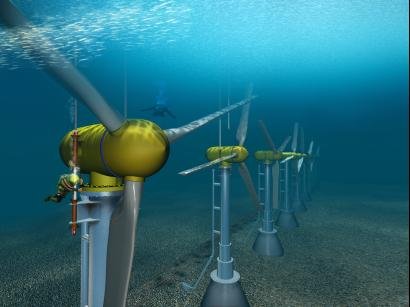
Yesterday, I wrote about how farming the ocean will solve the problem of how to feed an ever-swelling global population. Today, I will fill you in on how the ocean can solve our energy problems too. Is there anything the ocean can't do? Be dry, and not be wet. But that's about it.
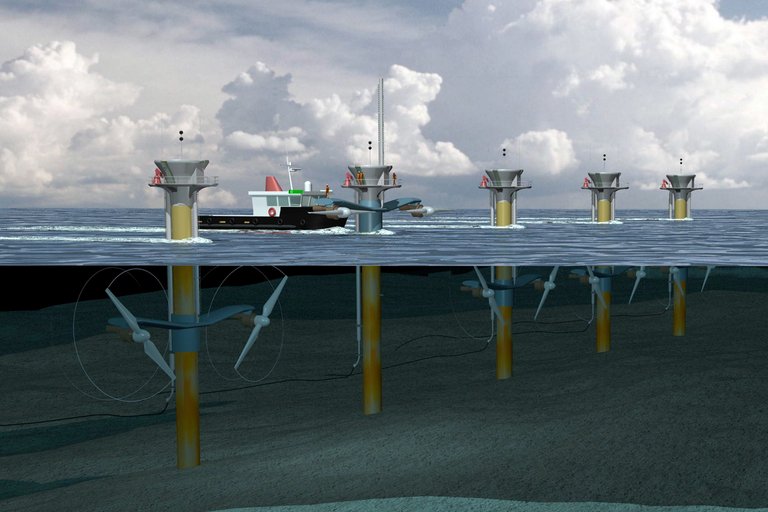
There's a couple different methods for extracting useful amounts of energy from the ocean that I'm gonna cover here. The first and most obvious is to adapt wind turbines for use underwater. Being that water is 700 times denser than air, you can get the same energy from a much weaker current, or vastly more energy from an equivalent flow rate.
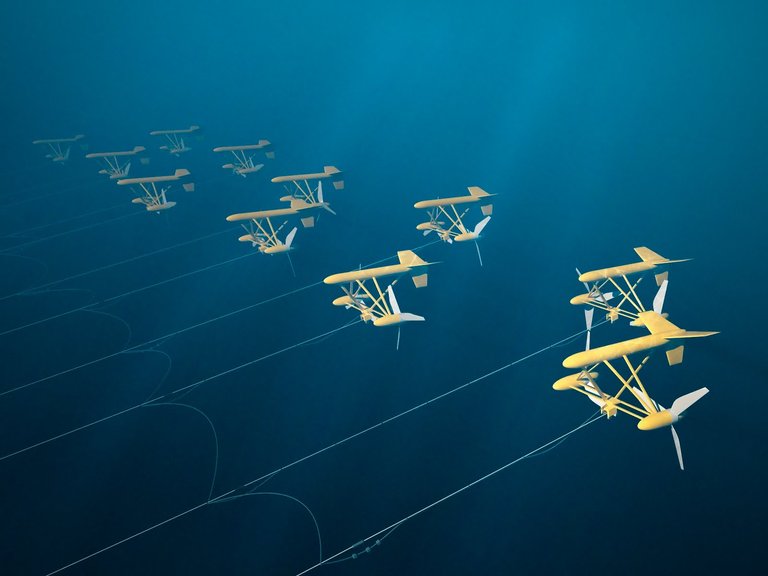
The energy output from the tide flowing in and out is not constant, but it is predictable, and the period of time between the tide coming in and going out is short enough that it's economically feasible to use large battery banks as a buffer to achieve constant output in spite of it.
The holy grail of oceanic turbine applications, however, is the gulf stream. A powerful continuous flow of seawater, conveniently right past the east coast of the US. Turbines placed in the gulf stream would operate non-stop, generating a constant output with no need for batteries. The flow is also sufficiently wide and strong that much larger turbines can be used.
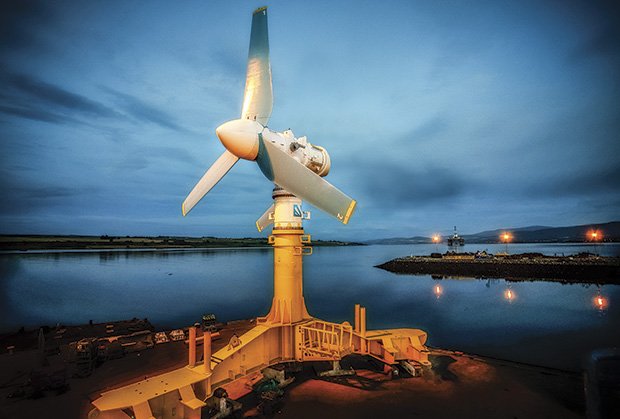
It's tough from that photo to get a sense of scale until you look more closely and realize, holy shit, it actually is that big. The output from a couple of these would be in the gigawatt range, comparable to a nuclear power plant but with none of the political barriers. Speaking of nuclear power...
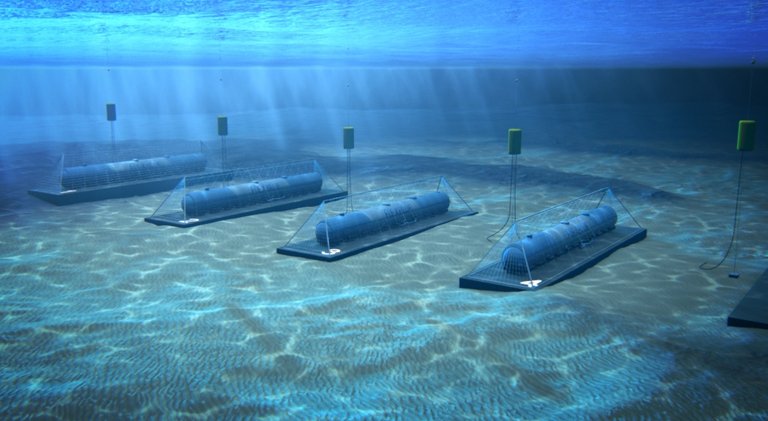
Flexblue is a French company which intends to establish undersea nuclear reactors. This is a much better idea than it appears at first glance. Immersing them in the ocean provides ubiquitous free coolant. Submerging them to a depth where the pressure inside the reactor chamber is identical to the water pressure outside eliminates the risk of explosion if there is a meltdown, containing it within the pressure hull.
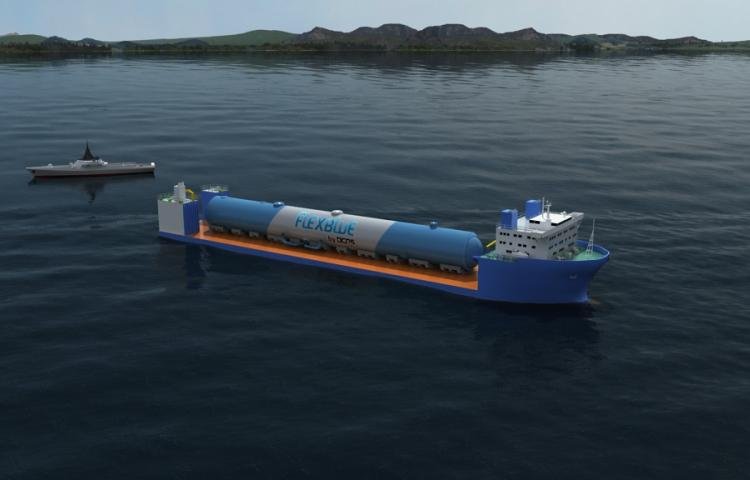
On top of that, seawater is opaque to ionizing radiation, and they would be emplaced far enough below the limits of scuba that I can scarcely imagine a more terrorist-proof reactor. Each one is essentially just the pressure hull and reactor from a nuclear submarine, but without the rest. Manufactured in the same coastal shipyards as nuclear subs, then transported to the desired site and sunk into place.
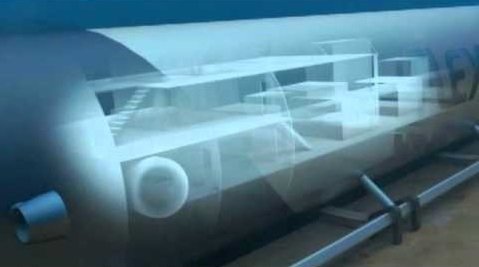
They are covered with protective nets to prevent depth charges from getting close enough to breach the hull, and the inside is accessible only via a proprietary docking collar that fits only one submersible, in possession of the Flexblue corporation. The interior is electrically lit, heated and has life support so that nuclear engineers can perform inspections and maintenance. It will be the largest stationary undersea habitat ever built.
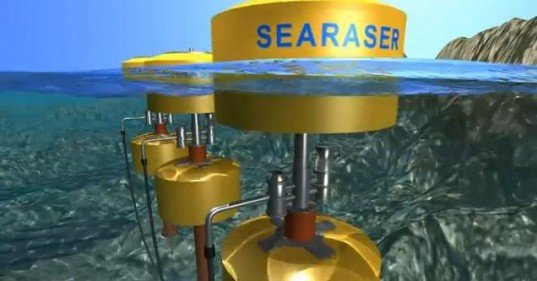
Moving on to something less exotic but no less promising, there's wave power. Where turbines generate energy from currents, wave generators extract energy from the upward and downward motion of waves. There are two major types of wave power generators in use today: Buoys, and "snakes".

The buoys work by driving the piston of a linear motor up and down, flipping its polarity each time the direction of movement reverses. The result is semi-continuous current for an individual buoy, and a continuous averaged current from all of the buoys at a particular site.
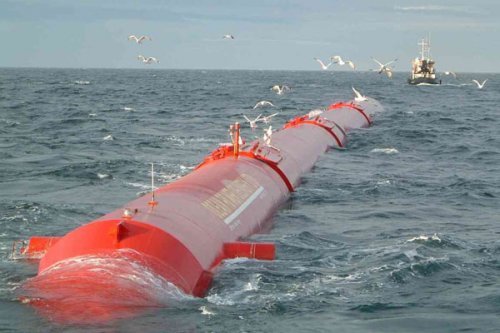
The "snake" type wave generator leverages the same basic forces, but in a different way. The undulation of the segmented body drives regular rotational generators where the joints flex, also reversing polarity when the direction of movement changes.
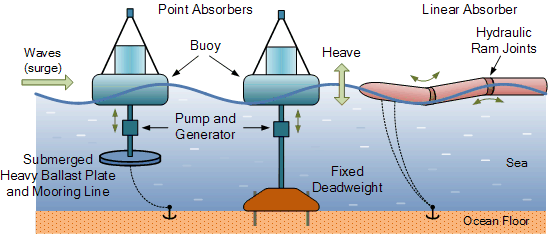
Both types have the same big problem: Moving parts. Made out of metal. Immersed in salt water. It doesn't take a rocket surgeon to figure out that maintenance will be a nightmare. With turbines there's just one moving part, and depending where you put them you can just scale it up. Wave generators, not so much. You just add more of them over a larger area, which only increases the maintenance nightmare.
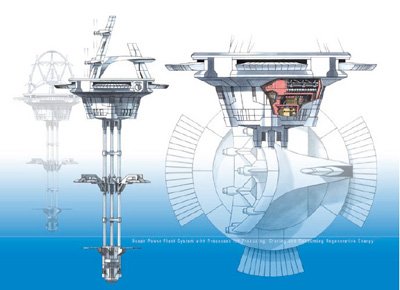
That brings me to OTEC, which stands for Oceanic Thermal Energy Conversion. It's really astoundingly clever and elegant. It turns the surface of the ocean around it into a solar collector! How does it do that? To understand, you'll need to know what a Stirling engine is and how it works.

A Stirling engine converts the latent energy from differences in temperature into movement. Specifically, if one side of the engine is hot and the other is cold, the shaft will spin. Hook that up to a dynamo, and you've got electricity. It also works in reverse! If you use a motor to spin the shaft, one side will get hot and the other cold. This configuration is known as a "heat pump", a low power alternative to air conditioning used in some cars.
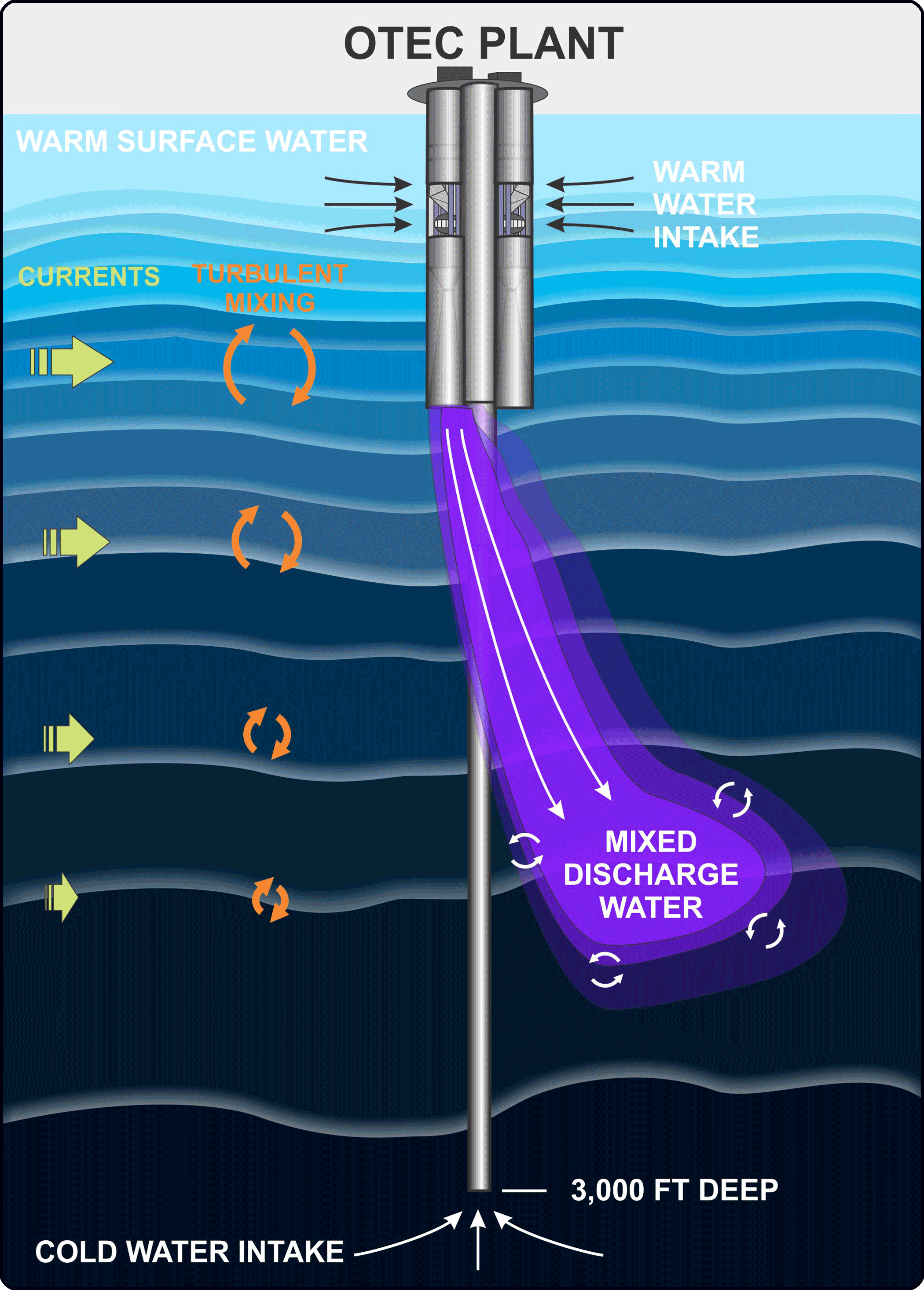
OTEC exploits this effect in the ocean, where the surface is much warmer than the lower layers. You don't have to go very deep before the sea becomes much colder! If you've ever gona scuba diving and passed through the thermocline, you know this all too well. Variations on this scheme exist, but they are all just some sort of heat exchanger.
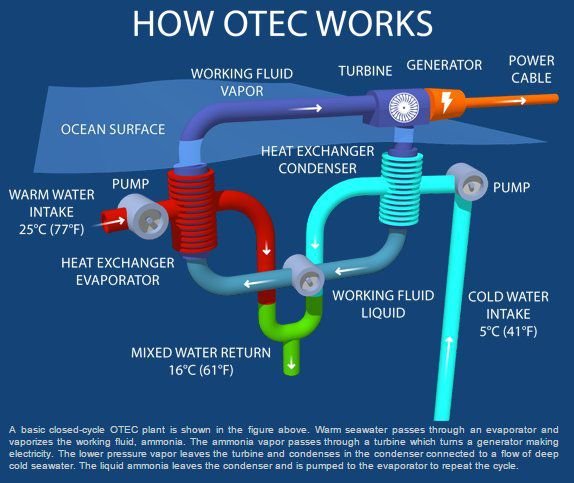
That's because the sun warms the ocean. But the ocean is basically a gigantic heat sink. The heat dissipates into the unimaginable mass of water, which is why the ocean plays the largest single part in regulating our planet's temperature.

If the OTEC plant is onshore, or close to shore, it has the added benefit of being able to send cold water through pipes in nearby homes to cool them during the Summer. As if that weren't enough, OTEC creates pockets of warmer than usual water at the bottom, which makes possible the deep water cultivation of valuable seafood like lobster and crab, simply requiring a netted pen built around the lowest point of the column.

Which of these promising technologies will dominate our clean energy future? It hardly matters, any will do. Each has its own set of merits and downsides, but they all crucially are capable of providing continuous power output, which makes them suitable for baseload generation. That's something solar and wind cannot do without substantial battery mass (enough for multiple days, instead of just the period between tides).

It's that uninterrupted output which makes them suitable replacements for coal fired power plants. Or oil, or natural gas. The largest gulf stream turbines being built today are even practical alternatives to nuclear, though I am pro-nuclear as it's still a step up over coal where atmospheric pollutants are concerned.
Most likely a mix of these technologies is the right answer, each utilized where local conditions call for it. Clean, uninterrupted energy from the sea. Enough, if we leverage the full potential of the gulf stream, to power this country many times over.
Thanks for the post. You explain these technologies well for broad readership.
Indeed, there are lots of people working hard on different technologies because they see the potential!
I also think there are many opportunities to learn more about decentralised organisation and to use ecology as a tool to teach the value of free markets:
https://steemit.com/science/@lanimal/dynamic-selection-within-diverse-plankton-communities-maintains-productivity-in-the-ocean
we need more realistic alternatives and stop hurting the planet! 8]good post @alexbeyman
Yep these underwater turbines can be a very good way to make and supply energy.
But in my opinion scientists already done their job and like you wrote we evolved from coal to nuclear energy.
All of these are fine and dandy but we still lack something.
But for this lets go to the basics:
We canot store it...just release it (sexual pun intended). So that means that we can create beautifull bombs. rockets and so on and on...
You can argue here and say: We can store it...
Nope ...we canot...
Example: We release nuclear energy ...like this : BOOM
First noticeable effect is that we wiped some continent.Second effect is the radiation witch is more deadly.
How to store this?
If anyone knew the aswer for this question it would be a more superb world.
We can try to store energy in batteries and there are so many types .
One of the best are lithium batteries that last very long time.
But even those canot store nuclear energy.
S.Hawking is thinking on another type of energy and those are the black holes.
In his book he wrotes that when a star is dying it begins to collapse on itself and this process creates a vacuum that sucks (pardon the expresion) everything from matter to time itself.
So this man Hawking calculated this but my question and I think that is his as well is:
As I see it inside is a place of storage ...and storage is what we need.
Well at least this is what I am thinking ...because I see that we as a race we already have so many different types of energy but we don't have a place to store it. I dunno when we will find the answer to this ...but if we do just imagine @alexbeyman a battery that can suplly one city for 10 years that can fit inside your pocket.
No need to store the energy created from a Liquid Fluoride Thorium Reactor. Like fire wood store the Thorium (a sphere the size of a golf ball will provide all of the energy need by a wasteful person for a lifetime. It doesn't take up much space and it's totally safe. Safer than firewood since it doesn't attract termites.
Note: nuclear power reactors can NOT explode. They can only meltdown. LIFTRs are impossible to meltdown.
I now that technically reactors cannot explode (only maybe if a trigger happy person who comes with some c4 and a deathwish).
Thorium or Th-232 is a very good example that you gave , it can be found in nature more even than uranium.
An last I agree again on the matter of size as well "the size of a golf ball "
"future needs" as well.
I gave the example the Stephen Hawking study opon: The black holes.
Now they generate HUGE quantities of energy so much that it will me more than we ever need.(and here you can add all the humans, the planet itself)
That type of fuel can be used for space travel.
In my opinion it is time for us to reach light speed already...
Just this month scientists "found out" that there is another planet at a distance of 1.5 light years form us and they name it Earth 2.0.
We already have power (dangeorus and deadly) now our next step is to implement it and evolve, search new things, never stopping.
Thanks @everittdmickey for a kind repply and information as well. In my repply to @alexbeyman I was taking not only our planet but our That's why I mentioned this type of energy because when I read top to bottom what @alexbeyman wrote I started to remember and see things in a positive way. Thank you again for a kind repply @everittdmickey !
"there is another planet at a distance of 1.5 light years from us and they name it Earth 2.0."
Really? Odd that. The nearest star to our sun is Alpha Centauri...it's about four light years away. Did earth 2 lose it's star? Is it out wandering alone by itself? Seems a bit chilly.
Kepler 452b (I dunno why scientists have such a fixation on code names) after that the name it Earth 2.0(It is confusing I know)
They (NASA) said that the Planet is six billion years old and has a 385 day year and orbits its star at the same distance as us.
And that it is 1.4(OK I wrote 1.5 because I wrote from what I remembered) light-years away in the constellation Cygnus.
I agree on your sentence :
I noticed too that NASA "just found out about another planets" ( I mean come on..really?)...that Uranus (pardon my french) is not a planet anymore and is something else...
In my opinon this scientists just waste time by labeling planets....meanwhile...they lie about what is out there....and believe me that there are plenty things out there .
I dont have the propper equipment to observe the stars or I am not a great mathematician to calculate the exact distance of the star (or star position)
So as a normal person I look for news and yes maybe somethimes I believe what these guys from NASA said in the papers .Yes @everittdmickey the original name of the Planet is
" Uranus (pardon my french) is not a planet anymore and is something else..."
Uranus is a gas giant. There is Jupiter, Saturn, Uranus and Neptune. All gas giants. Jupiter is such a LARGE gas giant that some callit a 'failed' brown dwarf (a type of star)...
Perhaps you are thinking of pluto
I'd be hesitant to say that Astronomers are lying. They have data to support their hypothesis. Do you have contradictory data?
Since the ocean covers the majority of the globes surface it makes sense our future relies on it. Here is a link to an Australian ocean energy company that's up and running with very innovative and simple technology http://carnegiewave.com/ceto-overview/
The ocean is the future of our world! We could also turn ocean water into drinking water with the proper water filtration technology. The government needs to spend money on ocean technology there are still parts of the ocean we have not reached the surface of because it is so deep and so big and vast.
That's called desalination and is in wide use today, particularly by wealthy middle eastern countries like Saudi Arabia. It is also a common method boats use to make drinking water.
Actually filters won't do that. You must be thinking about reverse osmosis
Excellent article.
Note: I was at one time involved in on shore wind turbines.
Before they were built the so called 'environmentalists' were ALL for them. They wanted them to be subsidized and installed everywhere.
They pretty much were.
Then environmentalists changed their minds and decided that windmills were EVIL. It doesn't matter what you do. The Luddites who claim to be environmentals are going to complain about it.
Your remarks about nukes is well taken. However you neglected to mention Thorium
Well done. Commented to save in the archives.
A friend of mine in Scotland was working on wave power. I should check in with him.
This plant does both electricity and uses the hydraulic pressure to remove the salt from ocean water. Two problems solved at once.
https://www.engineersaustralia.org.au/portal/news/worlds-first-wave-powered-desalination-plant-now-operational-perth
Thank you for sharing this material, I like what you posted. Thank you so much
Very interesting! Thanks. But what about the potential effects on the sea life?
Probably less harmful than the effects of continued oceanic warming and acidification.
Good information, but they are really many better ways to make energy and not so expensive + better for the environment. Check out "free energy nicola tesla" at Youtube for example. - Nevertheless, upvoted :)
There is no such thing as 'free energy' as it would violate the law of conservation, and Youtube is not where you should look for credible scientific information.